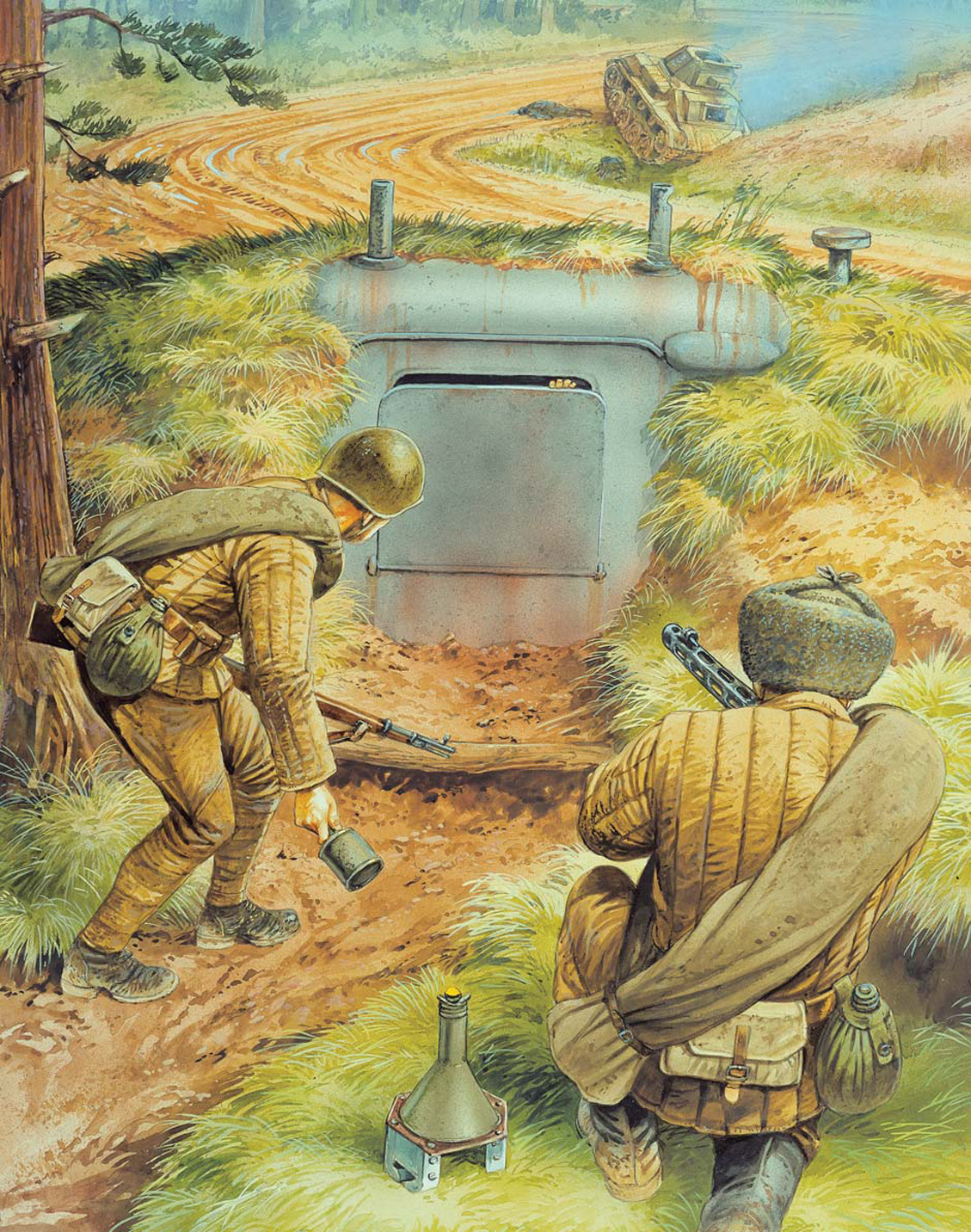

Soviet infantry clearing a pillbox, by Peter Dennis © Osprey Publishing Ltd. Taken from Elite 160: World War II Infantry Assault Tactics.
On an organizational level, the Red Army altered almost beyond recognition between 1941 and 1945. The cumbersome infantry formations and too-widely distributed tank forces of the Red Army contributed to their failure in the summer campaigns of 1941. Heinous losses necessitated that a new, leaner Red Army would be raised almost from scratch. In four years of war, the Soviets learned to mass their forces and firepower along narrow fronts. They learned to keep deep strategic reserves to exploit offensive success or to stabilise collapsing fronts. Most of all they learned how to encircle enemy formations and destroy them. They had learned from the masters of operational command, the Germans, and they had learned their lessons well.
This section contains 18 Theatre Selectors, which we sometimes refer to simply as selectors. Each Theatre Selector draws from the main Army List to describe a force that is broadly appropriate for a particular theatre and period of the Great Patriotic War. Some of the Theatre Selectors overlap in date because, on the 1,200 mile-long Eastern Front, the Red Army was often on the defensive in one area while on the offensive in others. A number of specific selectors are included for each of these phases.
We’ve placed an emphasis on the infantry-led battles in the East, so many of the Theatre Selectors are set in the northern and central areas of the front, with their denser terrain rather than the open steppes of the south. Equally, by 1943 the Red Army ‘settles in’ to a cohesive organisation very different from the patchwork of the desperate days of 1941–42. From this point onward, the changing army is mostly defined by the arrival of large numbers of new tanks and heavier guns.
Before playing a game, the players should choose which Theare Selectors they will be using to select their reinforced platoon from. If they so wish, opponents can ‘match-up’ their army lists to be contemporary with each other, so a Soviet reinforced platoon for Operation Bagration in 1944 would be fighting a German ‘Defence of the East’ force for 1944. Some Theatre Selectors, particularly the earliest ones when much equipment had been lost, are tailored to a specific time and place in the Red Army’s evolution. In general, however, the selectors can be used to represent fighting in the same period on different parts of the front.
Obviously, there is nothing to stop players experimenting and playing against other forces from different periods and theatres. Whilst not historically accurate, players often like to try ‘what-if’ type games. A particular favourite is pitting Soviet forces against American or British late war formations in a ‘Cold War’ scenario – a tough proposition for the Western Allies!
Regardless of whether you choose your forces from the generic Platoon Selector or any of the following Theatre Selectors, remember that any mix of up to three anti-tank teams counts as a single pick – meaning the where allowed 0–1 teams you can in fact take 0–3. This extra allowance reflects the high proportion of such teams amongst the Soviet army and is included as a special rule for these teams in the army list. Each unit is still a distinct unit and is represented by a die in the dice cup.

A Soviet force ready for deployment
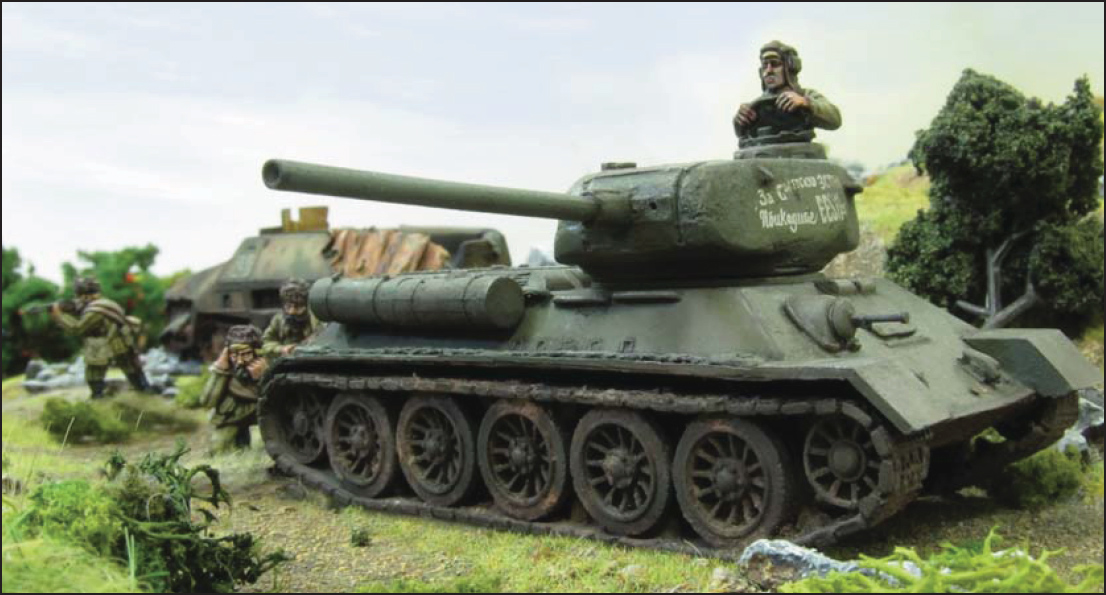
The famous T-35/85, supported by Red Army infantry

Street-fighting in Kholm, by Peter Dennis © Osprey Publishing Ltd. Taken from Campaign 245: Demyansk 1942–43.
The following rules are offered for use in historical games where both players agree. They are intended to reflect the kind of battlefield conditions that prevailed during periods of fighting on the Eastern Front.
In any game set during the final year of the war from mid-1944 onwards, the Red Army player may substitute the free Inexperienced rifle squad gained through the ‘quantity has a quality all of its own’ rule with either a free Inexperienced SU-76, medium mortar or ZiS-3 divisional gun.
The chaos that followed the German invasion resulted in fuel and ammunition shortages that severely hampered the Soviet mechanised forces. In any game set during 1941, tanks, armoured cars, tank destroyers, self-propelled artillery and anti-aircraft vehicles start the game with one pinning marker that may not be removed.
Vast areas of the Eastern Front were covered with forests and swamps that made off-road movement difficult even for tanks. All Open Ground is treated as Rough Ground instead.
The Russian winter proved almost as formidable opponent as the Soviet army and the winter of 1941–42 was especially severe. The Russians had learned how to fight in snowbound conditions during the Winter War against the Finns. All open ground counts as Rough Ground for all infantry, artillery, vehicles and non-Soviet tanks due to deep snow.
The Germans suffered terribly from the cold conditions of the Russian winter for which they were ill prepared. In a game fought during the winter of 1941–42, each non-Soviet unit must test against leadership at the beginning of the game. If the test is failed, each point by which it is failed indicates the loss of one soldier from the unit in the case of infantry or artillery, or immobilisation in the case of vehicles.
In accordance with the secret protocols of the non-aggression treaty between Germany and the Soviet Union, in August 1939 large areas of eastern Poland, Romania and the Baltic States had been occupied by the Red Army. Despite weeks of troop build-up, frequent Luftwaffe reconnaissance flights over Soviet territory and warnings from spies and deserters, the German invasion on 22 June 1941 – Operation Barbarossa – achieved complete strategic surprise. The Soviet ‘fortified regions’ along the frontier were pierced at many points by a torrent of fire and steel. To the astonishment of the Germans, many isolated Soviet garrisons resisted to the end even when surrounded and without hope of relief – an ominous foretaste of what was to come.
A Soviet force for the opening of Barbarossa must comprise one or more reinforced platoons picked from the following Army List. Each reinforced platoon is made up as follows:
1 Inexperienced Lieutenant – Junior or Senior
2 Inexperienced LMG squads (max 1 LMG per squad) or NKVD squads
Plus:
Headquarters
0–1 Captain
0–1 Commissar
0–1 Medic team
0–1 Forward Artillery Observer
Infantry
0–4 Infantry Squads: Inexperienced LMG squads (max 1 LMG per squad), NKVD squads, Cavalry squads
0–1 MMG team
0–1 HMG team
0–1 Anti-tank team: Anti-tank Rifle team, Ampulomet Anti-tank team, Tank Hunter Anti-tank team (may not have panzerfaust), Dog Mine Anti-tank team
0–1 Mortar team: light, medium or heavy
Artillery
0–1 Gun from:
Anti-tank gun: 45mm Model 1937
Artillery gun: light, medium or heavy
Anti-aircraft gun: 37mm 61-K Model 1939
Armoured Cars
0–1 Armoured car or Recce vehicle from: BA-10, BA-20
Tanks, Tank Destroyers, Self-propelled artillery and Anti-aircraft vehicles
0–1 Vehicle from: T-26 (any variant), BT-5/7, T-37, T-40, T-60, T-28, T-34, T-35, KV-1, KV-8, Tachanka, KV-2, Tokarev 4M Quad Maxim
Transports and Tows
0–1 Transport vehicle per infantry unit in the reinforced platoon from: Truck
0–1 Tow from: Truck, half-track truck, Komsomolets, artillery tractor
• Baptism of Fire: No Soviet forces can be Veteran

Soviet forces prepare to spring their ambush
Germany’s Army Group Centre was more heavily reinforced than the invasion groups to the north and south. As a result, a dangerous bulge had developed on the central axis as the Soviet southwestern front held its ground against Army Group South. On the orders of Stalin, more and more reinforcements were poured in to protect Kiev, capital of the Ukraine. Desperate fighting in the battles around Smolensk convinced the German high command that, in spite of its staggering losses, the Red Army was still a danger. In early July, Army Group Centre turned to assist Army Group South and trapped the entire mass of soldiers around Kiev – 43 Divisions – in a huge encirclement. The Red Army suffered 616, 304 dead or captured and 84,240 wounded in the subsequent series of battles. The 43 divisions of the southwestern front virtually ceased to exist in what Hitler called ‘the greatest battle in history’.
A Soviet force for the battle of Kiev must comprise one or more reinforced platoons picked from the following Army List. Each reinforced platoon is made up as follows:
1 Inexperienced Lieutenant – Junior or Senior
2 Rifle squads, Inexperienced LMG squads (max 1 LMG per squad), NKVD squads, Shtrafbat squads or People’s Militia squads
Plus:
Headquarters
0–1 Captain or Major
0–1 Commissar
0–1 Medic team
0–1 Forward Artillery Observer
Infantry
0–4 Infantry squads: Rifle squads, Inexperienced LMG squads (max 1 LMG per squad), NKVD squads, Shtrafbat squads, People’s Militia squads, Motorcycle squads, Cavalry squads.
0–1 MMG team
0–1 HMG team
0–1 Flamethrower team
0–1 Anti-tank team: Anti-tank Rifle team, Ampulomet Anti-tank team, Tank Hunter Anti-tank team (may not have panzerfaust), Dog Mine Anti-tank team
0–1 Mortar team: light, medium or heavy
Artillery
0–1 Gun from:
Anti-tank gun: 45mm Model 1937
Artillery gun: light, medium or heavy
Anti-aircraft gun: 37mm 61-K Model 1939
Armoured Cars
0–1 Armoured car or Recce vehicle: BA-10, BA-20
Tanks, Tank Destroyers, Self-propelled artillery and Anti-aircraft vehicles
0–1 Vehicle from: T-26 (any variant), BT-5/7, T-37, T-40, T-60, T-28, T-34, T-35, KV-1, KV-8, Tachanka, KV-2, Katyusha, Tokarev 4M Quad Maxim
Transports and Tows
0–1 Transport vehicle per infantry unit in the reinforced platoon from: Truck
0–1 Tow from: Truck, half-track truck, Komsomolets, artillery tractor
• Baptism of Fire: No Soviet forces can be Veteran
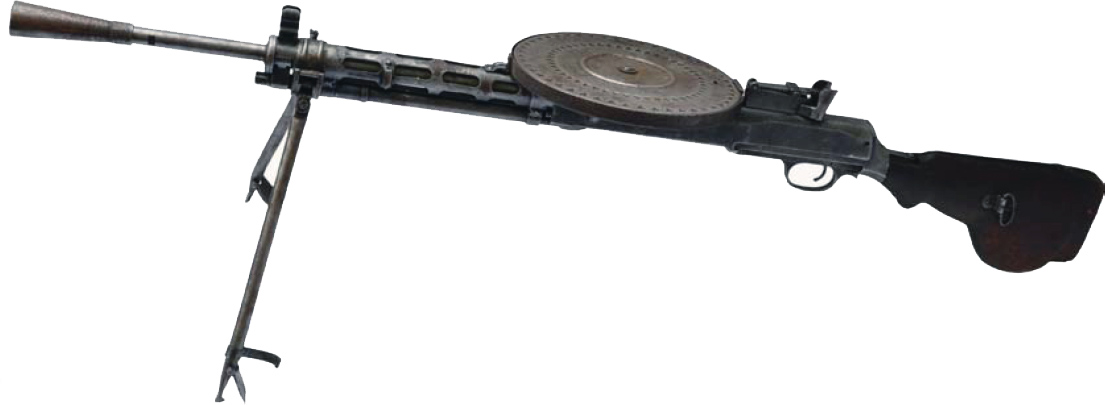
DP-28 light machine gun
The German Army Group North had been set Leningrad – the old Tsarist capital of St Petersburg and birthplace of the Revolution – as their primary objective. Fanatical Soviet resistance, thick forests and swamps impeded the Germans’ progress but they advanced steadily until they were in position to close a ring of steel around the city in combination with Finnish forces approaching from the North. In September, Marshal of the Soviet Union Giorgi Zhukov was sent to Leningrad as Stavka representative to weld back together its collapsing defences, a task that he performed with astounding alacrity and ruthless efficiency. Leningrad would remain under siege until 1944, but German forces were unable to destroy the city.
A Soviet force for the Leningrad approaches must comprise one or more reinforced platoons picked from the following Army List. Each reinforced platoon is made up as follows:
1 Inexperienced Lieutenant – Junior or Senior
2 Infantry squads: Rifle squads, LMG squads (max 1 LMG per squad), NKVD squads, Shtrafbat squads, Partisan squads, People’s Militia squads or Naval Squads
Plus:
Headquarters
0–1 Captain or Major
0–1 Commissar
0–1 Medic team
0–1 Forward Artillery Observer or Forward Air Observer
Infantry
0–4 Infantry squads: Rifle squads, Inexperienced LMG squads (max 1 LMG per squad), NKVD squads, Shtrafbat squads, Partisan squads, People’s Militia squads, Naval squads, Motorcycle squads, Cavalry squads
0–1 MMG team
0–1 HMG team
0–1 Sniper team
0–1 Flamethrower team
0–2 Anti-tank team: Anti-tank Rifle team, Ampulomet Anti-tank team, Tank Hunter Anti-tank team (may not have panzerfaust), Dog Mine Anti-tank team.
0–1 Mortar team: light, medium or heavy.
Artillery
0–1 Gun from:
Anti-tank gun: 45mm Model 1937, ZiS-3 Divisional gun, A-19 Field gun
Artillery gun: light, medium or heavy
Anti-aircraft gun: 37mm 61-K Model 1939, 25mm 72-K Model 1940
Armoured Cars
0–1 Armoured car or Recce vehicle: BA-10, BA-20
Tanks, Tank Destroyers, Self-propelled artillery and Anti-aircraft vehicles
0–1 Vehicle from: T-26 (any variant), BT-5/7, T-37, T-40, T-50, T-60, T-28, T-34, KV-1, KV-8, SU-76p, KV-2, Katyusha, Tokarev 4M Quad Maxim
Transports and Tows
0–1 Transport vehicle per infantry unit in the reinforced platoon from: Truck 0
0–1 Tow from: Truck, half-track truck, Komsomolets, artillery tractor
• Baptism of Fire: No Soviet forces can be Veteran
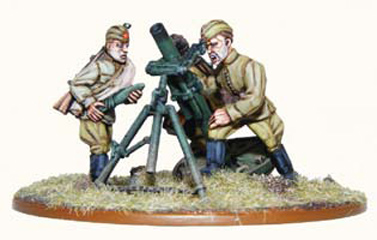
120mm heavy mortar team

Defenders of Leningrad (L–R): Red Army sergeant, Medical Branch lieutenant, naval infantryman of the Baltic Fleet, by Ronald Volstad © Osprey Publishing Ltd. Taken from Men-at-Arms 216: The Red Army of the Great Patriotic War 1941–45.
The great port-city of Sevastopol on the Crimean peninsula was the home base of the Soviet Black Sea fleet and heavily fortified with emplaced artillery, bunkers and minefields as well as the guns of the fleet itself. After their victory at Kiev, the German’s Army Group South was ordered to turn its attention to clearing out the Crimea and capturing Sevastopol by Führer Directive 33 on 23 July 1941, but they did not succeed in breaking through along the narrow isthmus connecting Crimea to the Ukraine until October. Soviet forces on the peninsula were strong and they were reinforced both directly and through naval landings made at Kerch on the east of the peninsula in December. The German forces were short of infantry and artillery so they made slow progress against the formidable defences of Sevastopol, only breaching them in June 1942 after months of bombardment performed primarily by the Luftwaffe. The heavy casualties and delays sustained in finally taking the port ensured that German forces in the Crimea were unavailable to support the push for Stalingrad that year.
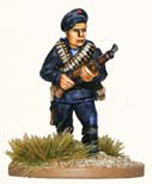
A Soviet force for the siege of Sevastopol must comprise one or more reinforced platoons picked from the following Army List. Each reinforced platoon is made up as follows:
1 (Inexperienced) Lieutenant – Junior or Senior
2 Infantry squads: Rifle squads, LMG squads (max 1 LMG per squad), Veteran squads (may not have panzerfaust and max 1 LMG per squad), People’s Militia squads or Naval Squads
Plus:
Headquarters
0–1 Captain or Major
0–1 Commissar
0–1 Medic team
0–2 Forward Artillery Observer or Forward Air Observer
Infantry
0–4 Infantry squads: Rifle squads, LMG squads(max 1 LMG per squad), Veteran squads (may not have panzer faust and max 1 LMG per squad), People’s Militia squads, Naval squads
0–1 MMG team
0–1 HMG team
0–1 Flamethrower team
0–2 Anti-tank team: Anti-tank Rifle team, Ampulomet Anti-tank team, Tank Hunter Anti-tank team (may not have panzerfaust), Dog Mine Anti-tank team
0–1 Mortar team: light, medium or heavy
Artillery
0–2 Guns from:
Anti-tank gun: 45mm Model 1937, ZiS-2 Anti-tank gun, ZiS-3 Divisional gun, A-19 Field gun
Artillery gun: light, medium or heavy
Anti-aircraft gun: 37mm 61-K Model 1939, 25mm 72-K Model 1940
Armoured Cars
0–1 Armoured car or Recce vehicle: BA-10, BA-20
Tanks, Tank Destroyers, Self-propelled artillery and Anti-aircraft vehicles
0–1 Vehicle from: T-26 (any variant), BT-5/7, T-37, T-40, T-60, T-28, T-34, KV-1, KV-8, Tachanka, KV-2, Katyusha, Tokarev 4M Quad Maxim
Transports and Tows
0–1 Transport vehicle per infantry unit in the reinforced platoon from: Truck
0–1 Tow from: Truck, half-track truck, Komsomolets, artillery tractor
• Baptism of Fire: No Soviet forces can be Veteran
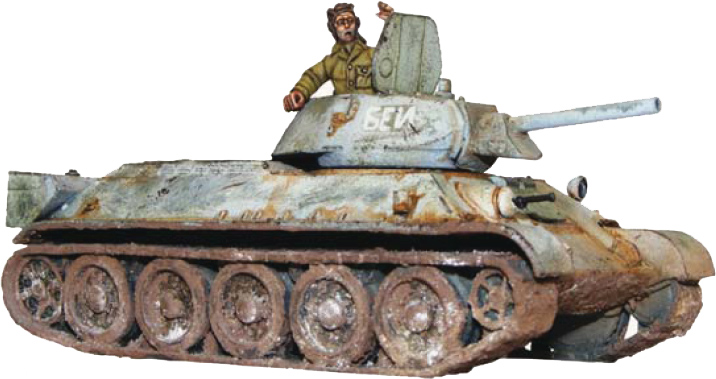
T-34/76 obr. 1941
The original planning for Barbarossa had dictated that the Russian capital be captured within the first four months. Bitter Soviet resistance to the north and south plus logistics problems incurred due to the poor roads and worsening weather brought the German advance to a virtual standstill by mid-October. The onset of cold weather froze the ground for long enough for the Germans to renew their offensive against Moscow with Operation Typhoon, but by this time Zhukov had been recalled from Leningrad to organise the defences of the capital and fresh Soviet reserves drawn from Siberia were massing. An attempted pincer movement to encircle Moscow was just barely held back as the Germans, who were poorly equipped for the Russian winter, began to suffer severe casualties in both men and machines due to the freezing temperatures.
A Soviet force for the defence of Moscow must comprise one or more reinforced platoons picked from the following Army List. Each reinforced platoon is made up as follows:
1 Lieutenant – Junior or Senior
2 Infantry squads: Rifle squads, LMG squads (max 1 LMG per squad), SMG squads, Guards squads (may not have panzerfaust and max 1 LMG per squad), NKVD squads, Shtrafbat squads, Partisan squads, Cavalry squads, People’s Militia squads, Siberian squads, Ski Troops squads or Airborne squads
Plus:
Headquarters
0–1 Captain or Major
0–1 Commissar
0–1 Medic team
0–1 Forward Artillery Observer or Forward Air Observer
Infantry
0–4 Infantry squads: Rifle squads, LMG squads (max 1 LMG per squad), SMG squads, Guards squads (may not have panzerfaust and max 1 LMG per squad), NKVD squads, Shtrafbat squads, Partisan squads, People’s Militia squads, Siberian squads, Ski Troops squads, Airborne Squads, Cavalry squads
0–1 MMG team
0–1 HMG team
0–1 Sniper team
0–1 Flamethrower team
0–2 Anti-tank team: Anti-tank Rifle team, Ampulomet Anti-tank team, Tank Hunter Anti-tank team (may not have panzerfaust), Dog Mine Anti-tank team
0–1 Mortar team: light, medium or heavy
Artillery
0–1 Gun from:
Anti-tank gun: 45mm Model 1937, ZiS-2 anti-tank gun, ZiS-3 Divisional gun, A-19 Field gun
Artillery gun: light, medium or heavy
Anti-aircraft gun: 37mm 61-K Model 1939, 25mm 72-K Model 1940
Armoured Cars
0–1 Armoured car or Recce vehicle: BA-10, BA-20
Tanks, Tank Destroyers, Self-propelled artillery and Anti-aircraft vehicles
0–1 Vehicle from: T-26 (any variant), BT-5/7,T-37, T-40, T-60, T-28, T-34, T-35, KV-1, KV-8, ZiS-30, Tachanka, KV-2, Katyusha, Tokarev 4M Quad Maxim
Transports and Tows
0–1 Transport vehicle per infantry unit in the reinforced platoon from: Truck, Aerosan
0–1 Tow from: Truck, half-track truck, Komsomolets, artillery tractor
• Battle Hardened: Only Soviet Headquarters and Infantry units can be Veteran
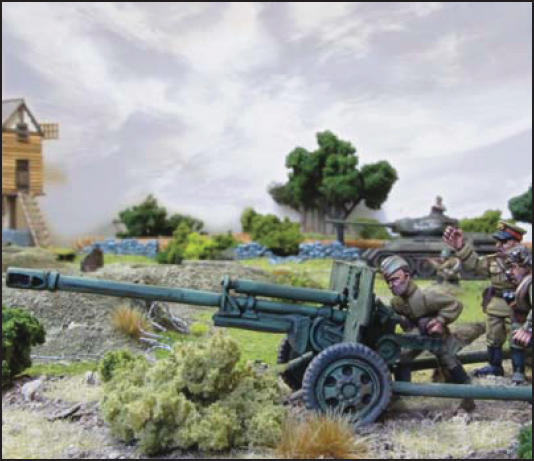
The Gods of War hammer German positions
By early December, the exhausted German formations attacking Moscow had been virtually reduced to skeletons by attrition and lack of supply. Some regiments were down to company strength and more than 130,000 cases of frostbite had been reported by German soldiers. As Operation Typhoon guttered to a halt, Stavka committed its carefully built-up reserve armies in a general counter-offensive to drive back the Germans. The Germans had been convinced that the Russians had no more reserves to commit and reeled back in confusion before the onslaught. Red Army cavalry, ski-troops and tanks circumvented the road-bound Wehrmacht formations and penetrated deep into the rear. Within weeks the Germans had been thrown back 100–250 kilometres from Moscow and Army Group Centre was teetering on the verge of complete collapse.
A Soviet force for the Moscow counter-offensive must comprise one or more reinforced platoons picked from the following Army List. Each reinforced platoon is made up as follows:
1 Lieutenant – Junior or Senior
2 Infantry squads: Rifle squads, LMG squads (max 1 LMG per squad), SMG squads, Guards squads (may not have panzerfaust and max 1 LMG per squad), Tank Rider squads, Shtrafbat squads, Partisan squads, Cavalry squads, Siberian squads, Ski Troops squads or Airborne squads
Plus:
Headquarters
0–1 Captain or Major
0–1 Commissar
0–1 Medic team
0–1 Forward Artillery Observer or Forward Air Observer
Infantry
0–4 Infantry squads: Rifle squads, LMG squads (max 1 LMG per squad), SMG squads, Guards squads (may not have panzerfaust and max 1 LMG per squad), Tank Riders squads, Shtrafbat squads, Partisan squads, Cavalry squads, Siberian squads, Ski Troops squads, Airborne squads
0–1 MMG team
0–1 HMG team
0–1 Sniper team
0–1 Flamethrower team
0–1 Anti-tank team: Anti-tank Rifle team, Ampulomet Anti-tank team, Tank Hunter Anti-tank team (may not have panzerfaust), Dog Mine Anti-tank team
0–1 Mortar team: light, medium or heavy
Artillery
0–1 Gun from:
Anti-tank gun: 45mm Model 1937, ZiS-2 anti-tank gun, ZiS-3 Divisional gun, A-19 Field gun
Artillery gun: light, medium or heavy
Anti-aircraft gun: 37mm 61-K Model 1939
Armoured Cars
0–1 Armoured car or Recce vehicle: BA-10, BA-20
Tanks, Tank Destroyers, Self-propelled artillery and Anti-aircraft vehicles
0–1 Vehicle from: T-26 (any variant), BT-5/7, T-37, T-40, T-60, T-34, KV-1, KV-8, ZiS-30, KV-2, Katyusha, Tokarev 4M Quad Maxim
Transports and Tows
0–1 Aerosan transport vehicle per Ski Troops squad in the reinforced platoon
0–1 Tow from: Half-track truck, Komsomolets, artillery tractor
• Clapped Out: Only Soviet Headquarters, Infantry and Artillery units can be Veteran
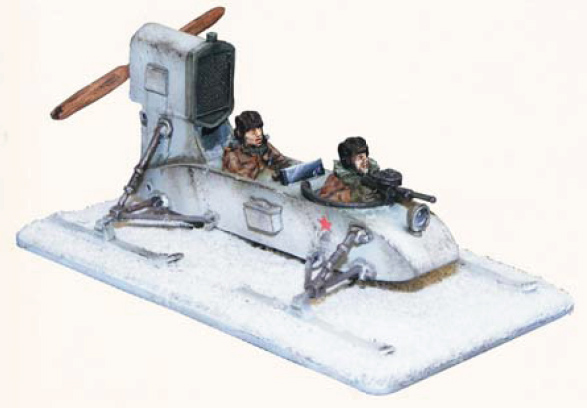
GAZ-98 Aerosan
The Moscow counter-offensive drove the fascists back and cut off many of their units, but as the fighting continued, the Red Army found itself unable to crush the Germans. Surrounded Wehrmacht formations grimly hung on in fortified villages and were able to stave off clumsy Soviet frontal attacks while being re-supplied by air drops from the Luftwaffe. Against the advice of his generals, Stalin ordered that the heavily fortified Rzhev–Vyazma salient close to Moscow be liquidated at all costs as part of a further general offensive intended to lift the siege of Leningrad. A series of attacks on the strongly defended salient produced no results and cost the Soviets between 500,000 and 1,000,000 casualties in a battle that became known as ‘the Rzhev Meat Grinder’.
A Soviet force for the battle of Rzhev must comprise one or more reinforced platoons picked from the following Army List. Each reinforced platoon is made up as follows:
1 Lieutenant – Junior or Senior
2 Infantry squads: Rifle squads, LMG Squads (max 1 LMG per squad), SMG squads, Guards squads (may not have panzerfaust and max 1 LMG per squad), Tank Rider squads, Shtrafbat squads, Partisan squads, Cavalry squads, Siberian squads, Ski Troops squads or Airborne squads
Plus:
Headquarters
0–1 Captain or Major
0–1 Commissar
0–1 Medic team
0–1 Forward Artillery Observer or Forward Air Observer
Infantry
0–4 Infantry squads: Rifle squads, LMG Squads (max 1 LMG per squad), SMG squads, Guards squads (may not have panzerfaust and max 1 LMG per squad), Tank Riders squads, Shtrafbat squads, Partisan squads, Cavalry squads, Siberian squads, Ski Troops squads, Airborne squads
0–1 MMG team
0–1 HMG team
0–1 Sniper team
0–1 Flamethrower team
0–2 Anti-tank team: Anti-tank Rifle team, Ampulomet Anti-tank team, Tank Hunter Anti-tank team (may not have panzerfaust), Dog Mine Anti-tank team
0–1 Mortar team: light, medium or heavy
Artillery
0–1 Gun from:
Anti-tank gun: 45mm Model 1937, M-42 anti-tank gun, ZiS-2 anti-tank gun, ZiS-3 Divisional gun, A-19 Field gun
Artillery gun: light, medium or heavy
Anti-aircraft gun: 37mm 61-K Model 1939
Armoured Cars
0–1 Armoured car or Recce vehicle: BA-10, BA-20, BA-64
Tanks, Tank Destroyers, Self-propelled artillery and Anti-aircraft vehicles
0–1 Vehicle from: T-26 (any variant), BT-5/7, T-37, T-40, T-60, T-34, KV-1, KV-8, KV-2, Katyusha, Tokarev 4M Quad Maxim
Transports and Tows
0–1 Aerosan transport vehicle per Ski Troops squad in the reinforced platoon
0–1 Tow from: Half-track truck, Komsomolets, artillery tractor
• Clapped Out: Only Soviet Headquarters, Infantry and Artillery units can be Veteran

Mosin-Nagant carbine with folding bayonet
Despite setbacks at Rzhev, Demyansk and Leningrad, Stalin was convinced that the strategic initiative still rested with the Soviet Union after the winter counter-offensive. He ordered a concentration of forces in the south to retake Kharkov, third-largest city in the Soviet Union and a key industrial centre. A great mass of newly raised rifle divisions and freshly built tanks were thrown into the offensive, but after some initial successes the old Red Army problems of inexperience and poor planning reared their ugly head. Unknown to the Soviets, the Germans had also concentrated forces in the area in preparation for their own summer offensive and were ideally placed to counter-attack. The thrust towards Kharkov was cut off and pounded into oblivion by German tanks, planes and artillery, costing the Red Army another 250,000 casualties and the loss of virtually all the tanks and guns committed.

A Soviet force for the second battle of Kharkov must comprise one or more reinforced platoons picked from the following Army List. Each reinforced platoon is made up as follows:
1 Lieutenant – Junior or Senior
2 Infantry squads: LMG squads (max 1 LMG per squad), SMG squads, Guards squads (may not have panzerfaust and max 1 LMG per squad), Tank Rider squads, Shtrafbat squads, Partisan squads, Cavalry squads, Motorcycle squads
Plus:
Headquarters
0–1 Captain or Major
0–1 Commissar
0–1 Medic team
0–1 Forward Artillery Observer
Infantry
0–4 Infantry squads: Rifle squads, LMG squads (max 1 LMG per squad), SMG squads, Guards squads (may not have panzerfaust and max 1 LMG per squad), Tank Riders squads, Shtrafbat squads, Partisan squads, Cavalry squads, Motorcycle squads
0–1 MMG team
0–1 HMG team
0–1 Sniper team
0–1 Flamethrower team
0–1 Anti-tank team: Anti-tank Rifle team, Ampulomet Anti-tank team, Tank Hunter Anti-tank team (may not have panzerfaust), Dog Mine Anti-tank team
0–1 Mortar team: light, medium or heavy
Artillery
0–1 Gun from:
Anti-tank gun: 45mm Model 1937, M-42 anti-tank gun, ZiS-2 anti-tank gun, ZiS-3 Divisional gun, A-19 Field gun
Artillery gun: light, medium or heavy
Anti-aircraft gun: 37mm 61-K Model 1939
Armoured Cars
0–1 Armoured car or Recce vehicle: BA-10, BA-20, BA-64
Tanks, Tank Destroyers, Self-propelled artillery and Anti-aircraft vehicles (None of these may be Veteran)
0–1 Vehicle from: T-26 (any variant), BT-5/7, T-37, T-40, T-60, T-70, T-34, KV-1, KV-8, Tachanka, Katyusha, Tokarev 4M Quad Maxim
Transports and Tows (None of these may be Veteran)
0–1 Transport vehicle per infantry unit in the reinforced platoon from: Truck, half-track truck, Gaz jeep
0–1 Tow from: truck, half-track truck, Komsomolets, artillery tractor
• Baptism of Fire: No Soviet forces can be Veteran

Red Army troops descend from their half-track to investigate an abandoned artillery piece
Flushed with their success at Kharkov, the Germans initiated their summer offensive ‘Case Blue’ to thrust across southern Russia into the Caucasus and seize the vital oil fields at Baku. Their first objective was capturing the city of Voronezh to gain a bridgehead over the Don river and protect the left flank of their attack. Although both Stalin and the Stavka had by this time embraced the idea of making strategic withdrawals to preserve fighting strength, they were determined to fight for Voronezh. A series of counter-attacks were made against German Panzer forces attempting to capture the city and bloody street fighting there delayed the German advance by several days, which would later prove vital in the battle for Stalingrad.

Soviet forces ambush a German patrol in the foothills of the Caucasus, by Peter Dennis © Osprey Publishing Ltd. Taken from Campaign 184: Stalingrad 1942.
A Soviet force for the battle of Voronzhev must comprise one or more reinforced platoons picked from the following Army List. Each reinforced platoon is made up as follows:
1 Lieutenant – Junior or Senior
2 Infantry squads: LMG Squads, SMG squads, Guards squads (may not have panzerfaust), Tank Rider squads, Shtrafbat squads, Cavalry squads, Motorcycle squads
Plus:
Headquarters
0–1 Captain or Major
0–1 Commissar
0–1 Medic team
0–1 Forward Artillery Observer
Infantry
0–4 Infantry squads: Rifle squads, LMG Squads (max 1 LMG per squad), SMG squads, Guards squads (may not have panzerfaust and max 1 LMG per squad), Tank Riders squads, Shtrafbat squads, Cavalry squads, Motorcycle squads
0–1 MMG team
0–1 HMG team
0–1 Sniper team
0–1 Flamethrower team
0–1 Anti-tank team: Anti-tank Rifle team, Ampulomet Anti-tank team, Tank Hunter Anti-tank team (may not have panzerfaust), Dog Mine Anti-tank team
0–1 Mortar team: light, medium or heavy
Artillery
0–1 Gun from:
Anti-tank gun: 45mm Model 1937, M-42 anti-tank gun, ZiS-2 anti-tank gun, ZiS-3 Divisional gun, A-19 Field gun
Artillery gun: light, medium or heavy
Anti-aircraft gun: 37mm 61-K Model 1939
Armoured Cars
0–1 Armoured car or Recce vehicle: BA-10, BA-20, BA-64
Tanks, Tank Destroyers, Self-propelled artillery and Anti-aircraft vehicles
0–1 Vehicle from: T-60, T-70, T-34, OT-34, KV-1, KV-8, Tachanka, Katyusha, Tokarev 4M Quad Maxim
Transports and Tows
0–1 Transport vehicle per infantry unit in the reinforced platoon from: Truck, half-track truck, Gaz jeep
0–11 Tow from: Truck, half-track truck, Komsomolets, artillery tractor
• Baptism of Fire: No Soviet forces can be Veteran
In August, German forces reached the mighty Volga river and entered the major industrial city of Stalingrad, gateway to the east. Stavka had recognised the direction of the fascist attack and ordered Stalingrad prepared for defence, drafting in all available reserves and every citizen between the ages of 15 and 55. Most of the 20-mile long city had been wrecked by Luftwaffe bombing and the defenders dug into the ruins turning every factory, office building and apartment block into a fortress. The Red Army kept their front lines as close as possible to the Germans, frequently interpenetrating the German positions in order to limit their use of artillery and air support. A bloody, gruelling close-quarter battle raged through the city for weeks with ever more German forces being drawn into the maelstrom while the Soviet defenders were sustained by a thin trickle of reinforcements from the east bank of the Volga. Only when the winter weather arrived, and the Soviet counter-offensives began to the north and south, did the Germans in Stalingrad realise they had caught themselves in a trap.
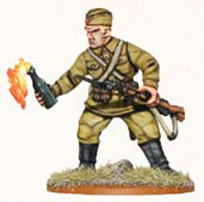
A Soviet force for the battle of Stalingrad must comprise one or more reinforced platoons picked from the following Army List. Each reinforced platoon is made up as follows:
In mid-September 1942 German troops seized a four-storey apartment house in a dominant position on 9th January square in the middle of Stalingrad. On 22 September, a counter-attack was made by a 30-strong platoon of the 13th Guards Rifle Division led by Junior Sergeant Yakov Pavlov as all of his senior officers and NCOs were dead or wounded at the time. Pavlov and his men recaptured the house after a fierce battle (some accounts say only four of the thirty emerged unwounded). The house was in a key strategic location with a clear line of sight for 1,000 meters to the north, south and west. Sergeant Pavlov was ordered to set up defensive positions to fight off the inevitable German counter-attacks.
Reinforcements were sent to Pavlov over the next few days, including a machine gun platoon commanded by a superior officer, Lt IF Afanasyev, but the location still became known as ‘Pavlov’s House’. It was defended continuously against multiple daily attacks for 58 days by 25 Red Army soldiers. Pavlov found that by placing his PTRS-41 anti-tank rifle on the roof, the German Panzers could not elevate their guns far enough to hit it and the AT rifle could easily penetrate the thin top armour of the tanks. Machine guns were emplaced in the cellars to fire out at ground level. More machine guns and mortars were positioned in the upper storeys, and barbed wire and minefields in the square below turned the entire area into a death trap. The defenders knocked holes through the basement walls to facilitate easier movement and dug a communication trench with a field telephone line running outside to the Volga for ammunition and reinforcements. Under the call sign ‘Lighthouse’ the defenders directed Soviet artillery on the east bank of the Volga against concentrations of German tanks and troops as they spotted them.
By mid-November, the defenders of Pavlov’s House were having to dash out between German attacks to kick over piles of corpses so that they couldn’t be used as cover by the next wave. On German maps, Pavlov’s House was marked ‘Festung’ – fortress – and despite major efforts to eradicate it, the strongpoint remained a thorn in their side throughout the battle. Marshal Chuikov, commander of the defence of Stalingrad, liked to joke that the Germans lost more men trying to take Pavlov’s House than they did capturing Paris (not quite true, but almost the case). Yakov Pavlov was decorated for his efforts with the Red Army’s highest award, the Hero of the Soviet Union, and went on to survive the war. The four-storey house that bore his name was rebuilt and serves as an apartment building to this day. A memorial there is built of bricks recovered from the east side of the building.

PPSh-41 sub-machine gun – rugged and reliable
1 Lieutenant – Junior or Senior
2 Infantry squads: Rifle squads, LMG squads, SMG squads, Guards squads, Veteran squads, NKVD squads, Shtrafbat squads, People’s Militia squads, Naval squads, Airborne squads
Plus:
Headquarters
0–1 Captain or Major
0–1 Commissar
0–1 Medic team
0–1 Forward Artillery Observer or Forward Air Observer
Infantry
0–4 Infantry squads: Rifle squads, LMG squads (max 1 LMG per squad), SMG squads, Guards squads (max 1 LMG per squad), Veteran squads (max 1 LMG per squad), NKVD squads, Shtrafbat squads, People’s Militia squads, Naval squads, Airborne Squads, Scout squads or a maximum of 1 Assault Engineers squad
0–1 MMG team
0–1 HMG team
0–2 Sniper teams
0–2 Flamethrower teams
0–2 Anti-tank team: Anti-tank Rifle team, Ampulomet Anti-tank team, Tank Hunter Anti-tank team, Dog Mine Anti-tank team
0–1 Mortar team: light, medium or heavy
0–1 Light mortar team
Artillery
0–2 Guns from:
Anti-tank gun: 45mm Model 1937, M-42 anti-tank gun, ZiS-2 anti-tank gun, ZiS-3 Divisional gun, 85mm Model 1939, A-19 Field gun
Artillery gun: light, medium or heavy
Anti-aircraft gun: 37mm 61-K Model 1939, 25mm 72-K Model 1940
Armoured Cars
0–1 Armoured car or Recce vehicle: BA-10, BA-20, BA-64
Tanks, Tank Destroyers, Self-propelled artillery and Anti-aircraft vehicles
0–1 Vehicle from: T-60, T-70, T-34, OT-34, KV-1, KV-1S, KV-8, KV-8S, Tachanka, KV-2, Katyusha, Tokarev 4M Quad Maxim
Transports and Tows
0–1 Transport vehicle per infantry unit in the reinforced platoon from: Truck, half-track truck, Gaz jeep
0–1 Tow from: Truck, half-track truck, Komsomolets, artillery tractor
• Fanatical Defence: With their backs to the Volga the defenders of Stalingrad fought with a stubbornness that the Germans found at first nonsensical, then frustrating and finally frightening. An army chosen from this selector can make any infantry units apart from Shtrafbat squads Fanatics at an additional cost of +3pts per man
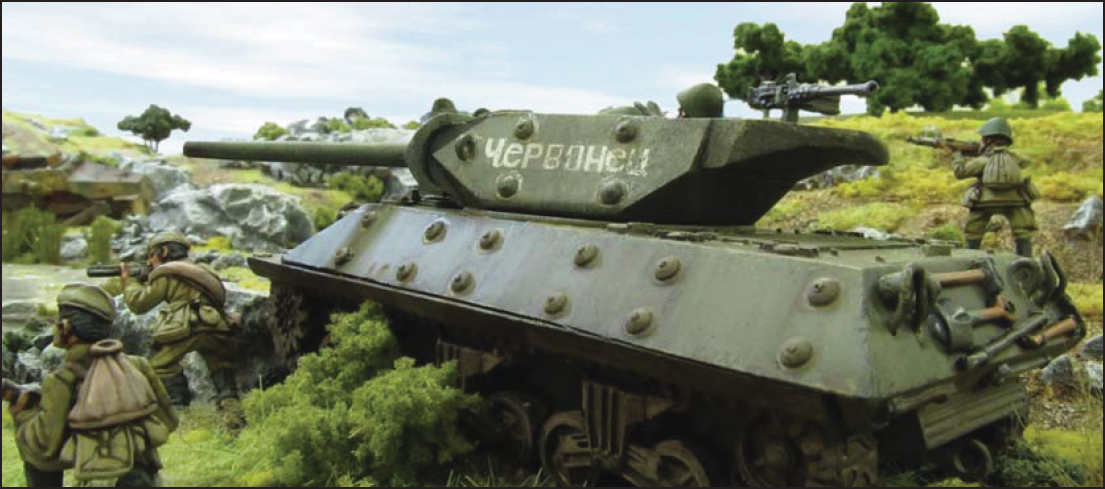
A lend-lease M10 tank destroyer scours the horizon for enemy armour
On 19 November the Red Army unleashed Operation Uranus, a twin-pronged attack north and south of Stalingrad with the aim of isolating the German forces in the city. The thinly held flanks of the Nazi positions around Stalingrad quickly caved in beneath the pressure and the arms of the Soviet pincer closed at Kalach on the Don River two days later. The move trapped over a quarter of a million Axis soldiers in and around Stalingrad – 21 field divisions and 100 battalion-sized units. Efforts to break through the Soviet ring were repulsed and attempts to resupply the trapped formations by air proved impossible. Three months later the surviving Germans were forced to surrender, making Stalingrad the first great strategic defeat suffered by the Wehrmacht during the war. There would be many more.
A Soviet force for Operation Uranus must comprise one or more reinforced platoons picked from the following Army List. Each reinforced platoon is made up as follows:
1 Lieutenant – Junior or Senior
2 Infantry squads: LMG squads, SMG squads, Guards squads, Veteran squads, Tank Rider squads, Shtrafbat squads, Partisan squads, Cavalry squads, Siberian squads, Ski Troops squads, Naval squads or Airborne Squads
Plus:
Headquarters
0–1 Captain or Major
0–1 Medic team
0–1 Forward Artillery Observer or Forward Air Observer
Infantry
0–4 Infantry squads: LMG squads (max 1 LMG per squad), SMG squads, Guards squads(max 1 LMG per squad), Veteran squads(max 1 LMG per squad), Tank Riders squads, Shtrafbat squads, Partisan squads, Cavalry squads, Siberian squads, Ski Troops squads, Naval squads, Airborne Squads, Scout squads or a maximum of 1 Assault Engineers squad
0–1 MMG team
0–1 HMG team
0–1 Sniper team
0–1 Flamethrower team
0–1 Anti-tank team: Anti-tank Rifle team, Ampulomet Anti-tank team, Tank Hunter Anti-tank team, Dog Mine Anti-tank team
0–1 Mortar team: light, medium or heavy
Artillery
0–1 Gun from:
Anti-tank gun: 45mm Model 1937, M-42 anti-tank gun, ZiS-2 anti-tank gun, ZiS-3 Divisional gun, A-19 Field gun
Artillery gun: light, medium or heavy
Anti-aircraft gun: 37mm 61-K Model 1939
Armoured Cars
0–1 Armoured car or Recce vehicle: BA-64
Tanks, Tank Destroyers, Self-propelled artillery and Anti-aircraft vehicles
0–1 Vehicle from: T-60, T-70, T-34, OT-34, KV-1, KV-1S, KV-8, KV-8S, Katyusha, Tokarev 4M Quad Maxim
Transports and Tows
0–1Transport vehicle per infantry unit in the reinforced platoon from: Truck, half-track truck, Gaz jeep
0–1 Aerosan transport vehicle per Ski Troops squad in the reinforced platoon
0–1 Tow from: Truck, half-track truck, Komsomolets, artillery tractor

Naval troops take up a defensive position
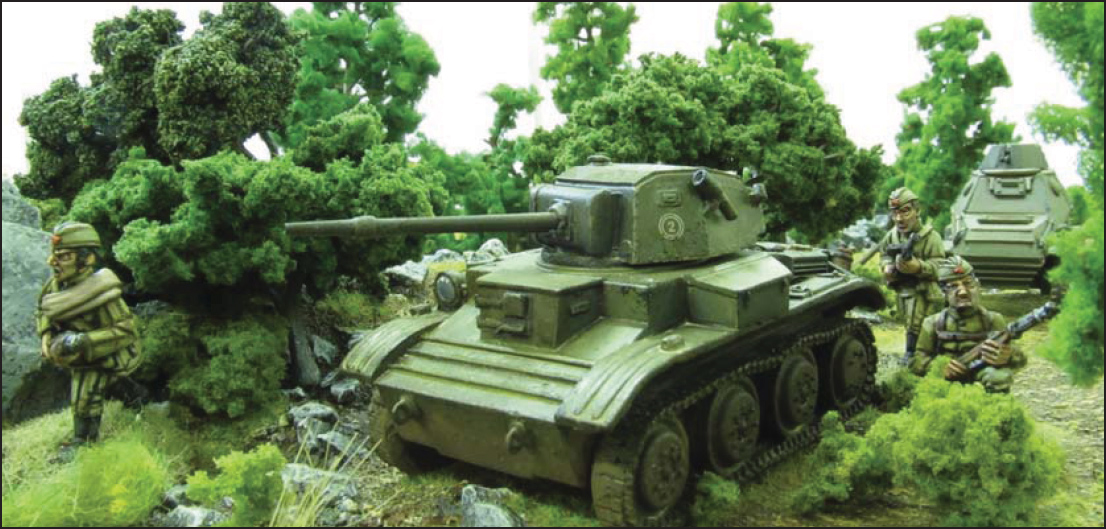
A Tetarch light tank at the vanguard of the Soviet reconnaissance force
With the Germans in crisis over Stalingrad, Soviet attacks in the south were expanded in scope and aim. Stavka began to think in terms of completely defeating the fascists by liberating the Ukraine in 1943. The Red Army launched Operation Star on 2 February – half a million men spearheaded by four tank armies with the objective of recapturing Belgorod, Kursk and Kharkov. Unusually, Hitler granted his commanders freedom of action to deal with the threat and they withdrew, surrendering Kharkov without a fight. On 20 February, the Germans counter-attacked the by-now exhausted and overextended Soviet armies, driving them back out of Kharkov after four days of bitter street fighting. The Germans’ other objective, the recapture of Kursk, was prevented by the spring thaw and was destined to be a much tougher battle.
A Soviet force for Operation Star must comprise one or more reinforced platoons picked from the following Army List. Each reinforced platoon is made up as follows:
1 Lieutenant – Junior or Senior
2 Infantry squads: LMG squads, SMG squads, Guards squads, Veteran squads, Tank Rider squads, Shtrafbat squads, Partisan squads, Cavalry squads, Siberian squads, Ski Troops squads, Naval squads or Airborne squads
Plus:
Headquarters
0–1 Captain or Major
0–1 Medic team
0–1 Forward Artillery Observer or Forward Air Observer
Infantry
0–4 Infantry squads: LMG squads (max 1LMG per squad), SMG squads, Guards squads (max 1 LMG per squad), Veteran squads (max 1 LMG per squad), Tank Riders squads, Shtrafbat squads, Partisan squads, Cavalry squads, Siberian squads, Ski Troops squads, Naval squads, Airborne Squads, Scout squads or a maximum of 2 Assault Engineers squads
0–1 MMG team
0–1 HMG team
0–1 Sniper team
0–1 Flamethrower team
0–2 Anti-tank team: Anti-tank Rifle team, Ampulomet Anti-tank team, Tank Hunter Anti-tank team, Dog Mine Anti-tank team
0–1 Mortar team: light, medium or heavy
Artillery
0–1 Gun from:
Anti-tank gun: M-42 anti-tank gun, ZiS-2 anti-tank gun, ZiS-3 Divisional gun, A-19 Field gun
Artillery gun: light, medium or heavy
Anti-aircraft gun: 37mm 61-K Model 1939
Armoured Cars
0–1 Armoured car or Recce vehicle: BA-64, BA-64B
Tanks, Tank Destroyers, Self-propelled artillery and Anti-aircraft vehicles
0–1 Vehicle from: T-60, T-70, T-34, OT-34, KV-1S, KV-8, KV-8S SU-76, SU-76i, SU-122, Katyusha, Tokarev 4M Quad Maxim
Transports and Tows
0–1 Transport vehicle per infantry unit in the reinforced platoon from: Truck, half-track truck, Gaz jeep
0–1 Aerosan transport vehicle per Ski Troops squad in the reinforced platoon
0–1 Tow from: Truck, half-track truck, Komsomolets, artillery tractor
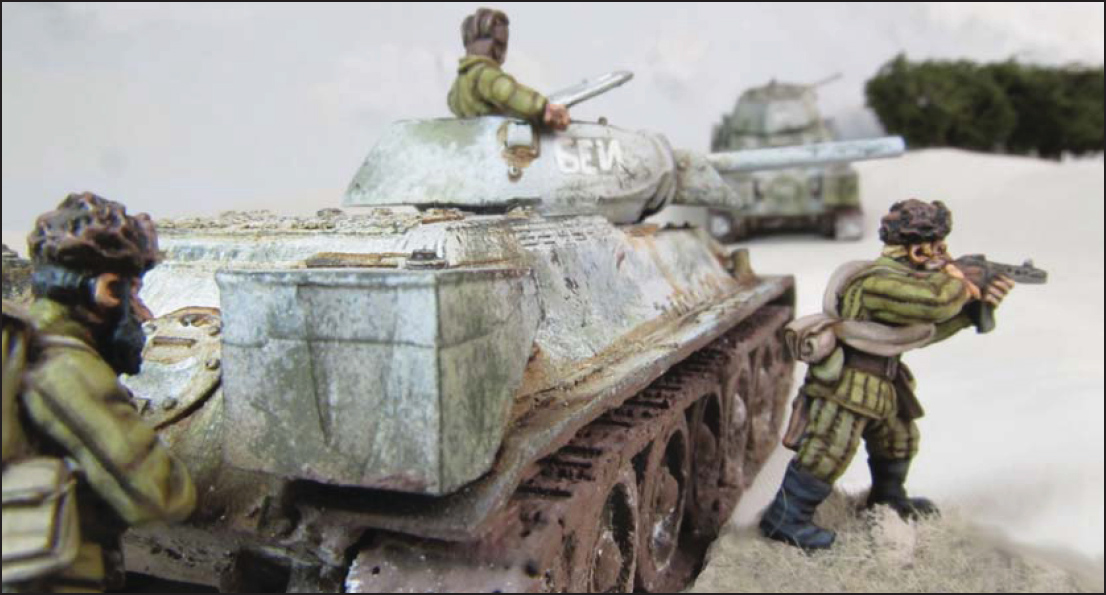
The Red Army advances relentlessly into the teeth of the Russian winter
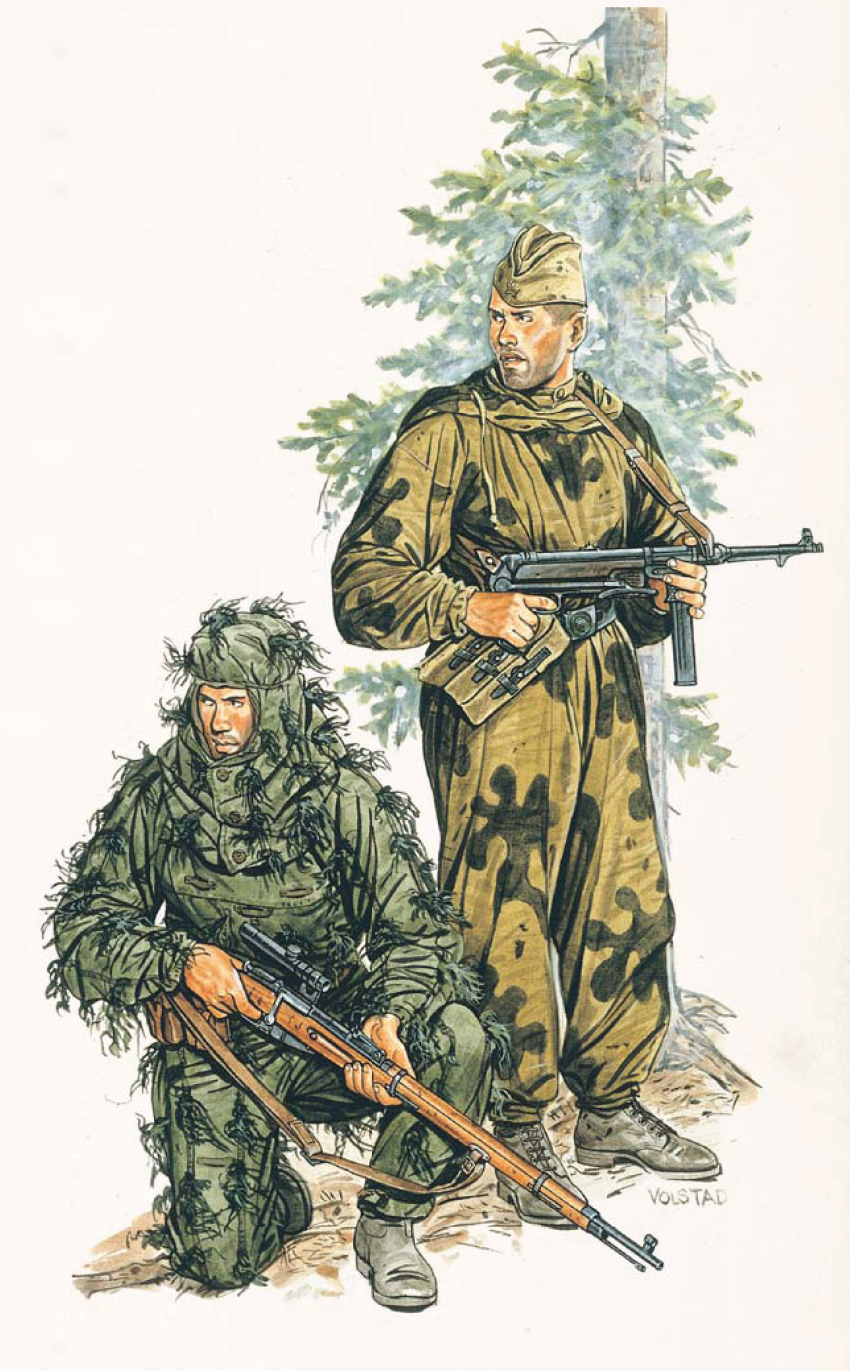
Red Army sniper and scout, by Ronald Volstad © Osprey Publishing Ltd. Taken from Men-at-Arms 216: The Red Army of the Great Patriotic War 1941-45.
After their success at Kharkov, the Germans determined to retain the initiative with a summer offensive aimed against the Soviet salient around Kursk. Two of the most powerful mechanised forces fielded by Germany during the war were concentrated with the objective of cutting off the Soviet armies at Kursk from north and south. The Red Army was to be drained of its strength before it could begin the by now inevitable winter counter-offensive. Stavka correctly predicted the coming offensive and entrenched their forces behind miles of minefields, barbed wire and entrenchments. Vast quantities of Soviet artillery were dug in to form strong points in echeloned defensive belts designed to bleed the Panzer forces white. Behind the defences, thousands of Red Army tanks stood ready to counter-attack once the German assault had exhausted itself. The battle began on 4 July and by 16 July the Germans were retreating to their start lines – the first time the German Blitzkrieg had failed. Successive Red Army attacks liberated Bryansk, Belogrod and Kharkov in July and August. The initiative on the Eastern Front would lie squarely with the Red Army from now on.
A Soviet force for the battle of Kursk must comprise one or more reinforced platoons picked from the following Army List. Each reinforced platoon is made up as follows:
1 Lieutenant – Junior or Senior
2 Infantry squads: LMG squads, SMG squads, Guards squads, Veteran squads, Tank Rider squads, Shtrafbat squads, Partisan squads, Cavalry squads
Plus:
Headquarters
0–1 Captain or Major
0–1 Medic team
0–1 Forward Artillery Observer or Forward Air Observer
Infantry
0–4 Infantry squads: LMG squads (max 1 LMG per squad), SMG squads, Guards squads (max 1 LMG per squad), Veteran squads (max 1 LMG per squad), Tank Riders squads, Shtrafbat squads, Partisan squads, Cavalry squads, Scout squads or a maximum of 2 Assault Engineers squads
0–1 MMG team
0–1 HMG team
0–2 Sniper team
0–2 Flamethrower team
0–2 Anti-tank team: Anti-tank Rifle team, Tank Hunter Anti-tank team, Dog Mine Anti-tank team
0–2 Mortar team: light, medium or heavy
Artillery
0–2 Gun from:
Anti-tank gun: M-42 anti-tank gun, ZiS-2 anti-tank gun, ZiS-3 Divisional gun, 85mm Model 1939, A-19 Field gun
Artillery gun: light, medium or heavy
Anti-aircraft gun: 37mm 61-K Model 1939
Armoured car
0–1 Armoured car or Recce vehicle: BA-64, BA-64B
Tanks, Tank Destroyers, Self-propelled artillery and Anti-aircraft vehicles
0–1 Vehicle from: T-60, T-70, T-34, OT-34, KV-1S, KV-8, KV-8S, SU-76, SU-76i, SU-122, SU-152, Katyusha, Tokarev 4M Quad Maxim
Transports and Tows
0–1 Transport vehicle per infantry unit in the reinforced platoon from: Truck, half-track truck, Gaz jeep
0–1 Tow from: Truck, half-track truck, Komsomolets, artillery tractor

T-34/76 obr. 1943 and tank riders

Heroes of Kursk (L–R): Red Army lieutenant, sniper, tank crewman, by Ronald Volstad © Osprey Publishing Ltd. Taken from Men-at-Arms 216: The Red Army of the Great Patriotic War 1941–45.
In January 1943, the Soviet Operation Iskra (‘Spark) had opened a narrow land corridor to Leningrad, but the city remained besieged through the rest of the year. In January 1944, once the ice on Lake Ladoga had thickened sufficiently to move tanks and artillery to the front, the Soviets went on the offensive in an effort to break the siege altogether. Their opponents, Army Group North, had already been weakened by the reassignment of some of their most experienced divisions to attempt to stem Red Army breakthroughs far to the south. The first few days of the Soviet operation were hampered by thick fog, but the Red Army pushed steadily forward. Thanks to the dense, heavily fortified terrain, the Germans were able to retreat in an orderly fashion to the ‘Panther Line’ near the river Narva with the Red Army snapping at their heels every step of the way. The siege of Leningrad was finally lifted after 900 days, an event celebrated with a 324 gun salute (including Katyushas!) on 27 January 1944.
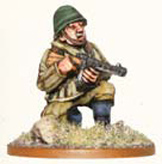
A Soviet force for the Leningrad–Novgorod offensive must comprise one or more reinforced platoons picked from the following Army List. Each reinforced platoon is made up as follows:
1 Lieutenant – Junior or Senior
2 Infantry squads: LMG squads, SMG squads, Guards squads, Veteran squads, Tank Rider squads, Shtrafbat squads, Partisan squads, Cavalry squads, Ski Troops squads
Plus:
Headquarters
0–1 Captain or Major
0–1 Medic team
0–1 Forward Artillery Observer or Forward Air Observer
Infantry
0–4 Infantry squads: LMG squads (max 1 LMG per squad), SMG squads, Guards squads (max 1 LMG per squad), Veteran squads (max 1 LMG per squad), Tank Riders squads, Shtrafbat squads, Partisan squads, Cavalry squads, Scout squads or a maximum of 2 Assault Engineers squads, Ski Troops squads
0–1 MMG team
0–1 HMG team
0–1 Sniper team
0–1 Flamethrower team
0–1 Anti-tank team: Anti-tank Rifle team, Tank Hunter Anti-tank team
0–1 Mortar team: light, medium or heavy
Artillery
0–1 Gun from:
Anti-tank gun: M-42 anti-tank gun, ZiS-2 anti-tank gun, ZiS-3 Divisional gun, 85mm Model 1939, A-19 Field gun
Artillery gun: light, medium or heavy
Anti-aircraft gun: 37mm 61-K Model 1939
Armoured Cars
0–1 Armoured car or Recce vehicle: BA-64, BA-64B
Tanks, Tank Destroyers, Self-propelled artillery and Anti-aircraft vehicles
0–1 Vehicle from: T-37, T-40, T-50, T-60, T-70, T-34, OT-34, KV-1S, KV-8, KV-8S, KV-85/IS-1, SU-76, SU-85, SU-122, SU-152, Tachanka, Katyusha, Tokarev 4M Quad Maxim
Transports and Tows
0–1 Transport vehicle per infantry unit in the reinforced platoon from: Truck, half-track truck, Gaz jeep, Aerosan
0–1 Tow from: Truck, half-track truck, Komsomolets, artillery tractor
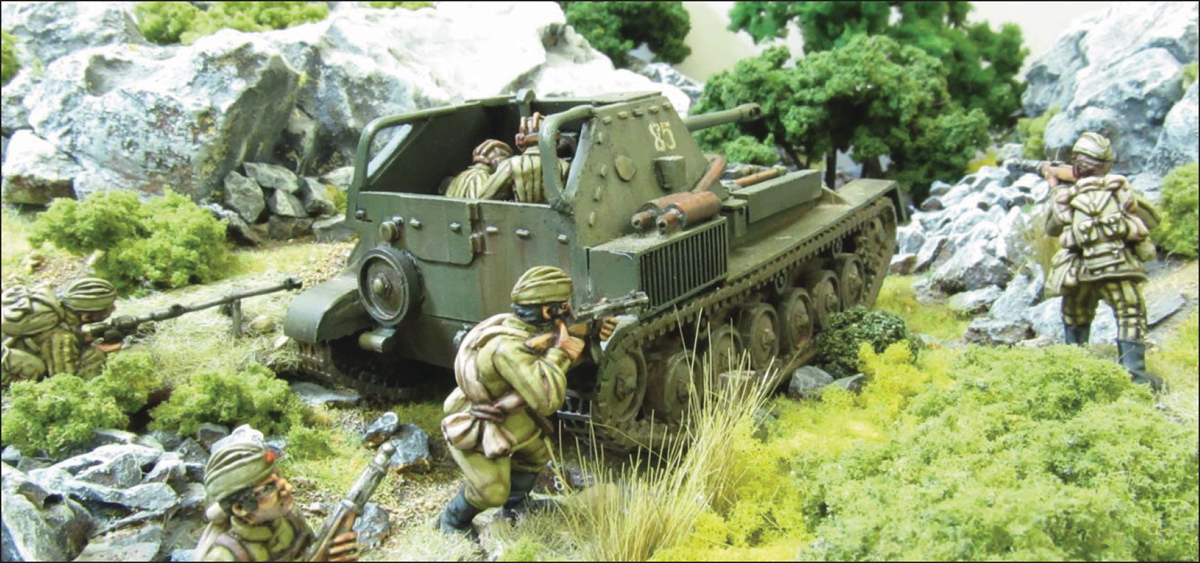
SU-76 with infantry support

T-34/76 obr.1942 medium tank
As predicted, the Red Army winter offensive was devastating and for the rest of the year the Germans were in almost constant retreat. Smolensk and Kiev were liberated by the advancing Soviet armies and the Ukraine virtually cleared by the end of 1943. To the north, the siege of Leningrad was finally lifted early in 1944. By the summer of 1944, the Red Army had reached the borders of Belorussia and eastern Poland where the German defences were firmly anchored by fortifications and minefields across much of the front. The Red Army was a very different entity to that of 1941–42. By now large Soviet mechanised formations and tank armies were capable of the kind of mobile warfare and deep exploitation the Wehrmacht had used to subjugate all of Western Europe. New heavy tanks and tank destroyers had been created to face the Germans’ Tiger and Panther tanks, denying them even that technical edge against the overwhelming hordes they faced.
A Soviet force for operation Bagration must comprise one or more reinforced platoons picked from the following Army List. Each reinforced platoon is made up as follows:
1 Lieutenant – Junior or Senior
2 Infantry squads: LMG squads, SMG squads, Guards squads, Veteran squads, Tank Rider squads, Shtrafbat squads, Partisan squads, Cavalry squads
Plus:
Headquarters
0–1 Captain or Major
0–1 Medic team
0–2 Forward Artillery Observer or Forward Air Observer
Infantry
0–4 Infantry squads: LMG squads (max 1 LMG per squad), SMG squads, Guards squads (max 1 LMG per squad), Veteran squads (max 1 LMG per squad), Tank Riders squads, Shtrafbat squads, Partisan squads, Cavalry squads, Scout squads or Assault Engineers squads
0–1 MMG team
0–1 HMG team
0–1 Sniper team
0–1 Flamethrower team
0–1 Anti-tank team: Anti-tank Rifle team, Tank Hunter Anti-tank team.
0–1 Mortar team: light, medium or heavy.
Artillery
0–2 Gun from:
Anti-tank gun: 45mm Model 1937, M-42 anti-tank gun, ZiS-2 anti-tank gun, ZiS-3 Divisional gun, A-19 Field gun, BS-3 anti-tank gun
Artillery gun: light, medium or heavy
Anti-aircraft gun: 37mm 61-K Model 1939
Armoured Cars
0–1 Armoured car or Recce vehicle: BA-64, BA-64B, BA-64DShK
Tanks, Tank Destroyers, Self-propelled artillery and Anti-aircraft vehicles
0–1 Vehicle from: T-60, T-70, T-34, OT-34, T-34/85, OT-34/85, KV-85/IS-1, IS-2, SU-85, ISU-122, Tachanka, SU-76, SU-122, SU-152, Katyusha, Tokarev 4M Quad Maxim
Transports and Tows
0–1 Transport vehicle per infantry unit in the reinforced platoon from: Truck, half-track truck, Gaz jeep
0–1 Tow from: Truck, half-track truck, Komsomolets, artillery tractor

Tokarev SVT-40 semi-automatic rifle
The success of Operation Bagration carried the Red Army all the way across eastern Poland to the Vistula River and the capital, Warsaw. With shocking ruthlessness, the Soviets remained inactive through the autumn while the Poles attempted an uprising in Warsaw and the Germans punished them horrifically for their courage. The Red Army advance was renewed in January 1945 as the Soviet tanks broke out of their bridgeheads on the Vistula and set their sights on the River Oder – a little more than forty miles from Berlin. By the Vistula– Oder offensive, the Soviets outnumbered the Germans five to one in men, guns, tanks and aircraft. Veteran Wehrmacht survivors were still exacting a dreadful toll on the Red Army, but for the disintegrating Third Reich it was now only a matter of time before the final blow fell.
A Soviet force for the Vistula–Oder offensive must comprise one or more reinforced platoons picked from the following Army List. Each reinforced platoon is made up as follows:
1 Lieutenant – Junior or Senior
2 Infantry squads: LMG squads, SMG squads, Guards squads, Veteran squads, Tank Rider squads, Shtrafbat squads, Cavalry squads
Plus:
Headquarters
0–1 Captain or Major
0–1 Medic team
0–2 Forward Artillery Observer or Forward Air Observer
Infantry
0–4 Infantry squads: LMG squads (max 1 LMG per squad), SMG squads, Guards squads (max 1 LMG per squad), Veteran squads (max 1 LMG per squad), Tank Riders squads, Shtrafbat squads, Cavalry squads, Scout squads or Assault Engineers squads
0–1 MMG team
0–1 HMG team
0–1 Sniper team
0–1 Flamethrower team
0–1 Anti-tank team: Anti-tank Rifle team, Tank Hunter Anti-tank team
0–2 Mortar teams: light, medium or heavy
Artillery
0–2 Gun from:
Anti-tank gun: 45mm Model 1937, M-42 anti-tank gun, ZiS-2 anti-tank gun, ZiS-3 Divisional gun, A-19 Field gun, BS-3 anti-tank gun
Artillery gun: light, medium or heavy
Anti-aircraft gun: 37mm 61-K Model 1939
Armoured Cars
0–1 Armoured car or Recce vehicle: BA-64, BA-64B, BA-64DShK
Tanks, Tank Destroyers, Self-propelled artillery and Anti-aircraft vehicles
0–1 Vehicle from: T-60, T-70, T-34, OT-34, T-34/85, OT-34/85, IS-2, SU-85, ISU-122, Tachanka, SU-76, SU-100, SU-152, Katyusha, Tokarev 4M Quad Maxim
Transports and Tows
0–1 Transport vehicle per infantry unit in the reinforced platoon from: Truck, half-track truck, Gaz jeep
0–1 Tow from: Truck, half-track truck, Komsomolets, artillery tractor
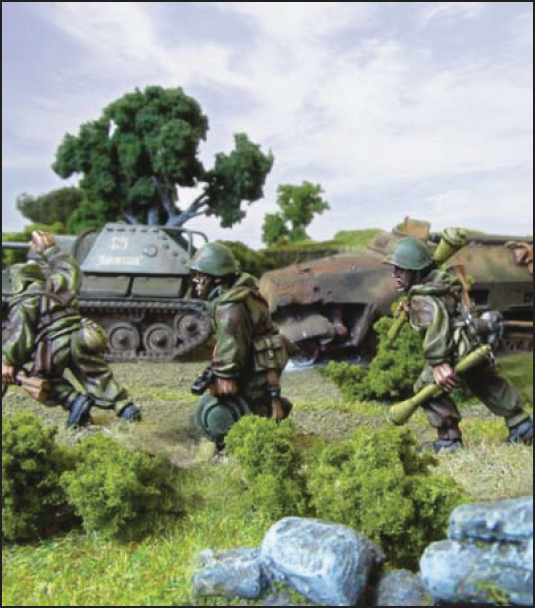
Soviet Engineers redeploy
The extended Soviet spearheads turned aside in March to clear their flanks of German forces in Pomerania and East Prussia, before making the final drive on Berlin in April. The last major defensive line before reaching the capital was the Seelow Heights, a low range of hills overlooking the river Oder where it was crossed by the east–west Berlin autobahn. While Soviet armies attacked to the north and south, Marshal Zhukov was given the task of breaching the last, and toughest, defences of World War II. Even when outnumbered ten to one, German tactical flair allowed them to once again delay the inevitable and inflict heavy casualties on the Red Army, but after four days of bloody fighting, the way to Berlin was open.
A Soviet force for the Seelow Heights must comprise one or more reinforced platoons picked from the following Army List. Each reinforced platoon is made up as follows:
1 Lieutenant – Junior or Senior
2 Infantry squads: LMG squads, SMG squads, Guards squads, Veteran squads, Tank Rider squads, Shtrafbat squads, Assault Engineers squads
Plus:
Headquarters
0–1 Captain or Major
0–1 Medic team
0–2 Forward Artillery Observer or Forward Air Observer
Infantry
0–4 Infantry squads: LMG squads (max 1 LMG per squad), SMG squads, Guards squads (max 1 LMG per squad), Veteran squads (max 1 LMG per squad), Tank Riders squads, Shtrafbat squads, Scout squads or Assault Engineers squads
0–1 MMG team
0–1 HMG team
0–1 Sniper team
0–1 Flamethrower team
0–1 Anti-tank team: Anti-tank Rifle team, Tank Hunter Anti-tank team
0–2 Mortar teams: light, medium or heavy
Artillery
0–2 Gun from:
Anti-tank gun: 45mm Model 1937, M-42 anti-tank gun, ZiS-2 anti-tank gun, ZiS-3 Divisional gun, A-19 Field gun, BS-3 anti-tank gun
Artillery gun: light, medium or heavy
Anti-aircraft gun: 37mm 61-K Model 1939
Armoured Cars
0–1 Armoured car or Recce vehicle: BA-64, BA-64B, BA-64DShK
Tanks, Tank Destroyers, Self-propelled artillery and Anti-aircraft vehicles
0–2 Vehicle from: T-60, T-70, T-34, OT-34, T-34/85, OT-34/85, IS-2, SU-85, ISU-122, SU-76, SU-100, SU-152, Katyusha, Tokarev 4M Quad Maxim
Transports and Tows
0–1 Transport vehicle per infantry unit in the reinforced platoon from: Truck, half-track truck, Gaz jeep
0–1 Tow from: Truck, half-track truck, Komsomolets, artillery tractor

A T-34/76 hunts Fascist prey...
Soviet forces began their bombardment of Berlin on 20 April 1945. For the final act, Stavka encircled the German capital over the next three days with 2.5 million men, 6,250 tanks, and almost 45,000 artillery pieces. The shattered divisions facing them were a mixture of Volkssturm militia, Wehrmacht troops, Hitler Youth and SS units clinging to concentric rings of defences in the bombed-out ruins of Berlin. Fierce street battles raged for a week as the Soviet forces pushed into the heart of Berlin, blasting their way forward with heavy tank support in the face of panzerfausts and fanatical resistance.
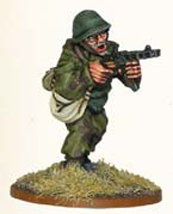
On 30 April, as Red Army soldiers fought to capture the Reichstag, Adolf Hitler committed suicide inside his Fuhrerbunker. Two days later, Berlin was surrendered to Marshal Chuikov, the redoubtable defender of Stalingrad. In Europe, World War II was all but over.
A Soviet force for the Seelow Heights must comprise one or more reinforced platoons picked from the following Army List. Each reinforced platoon is made up as follows:
1 Lieutenant – Junior or Senior
2 Infantry squads: LMG squads, SMG squads, Guards squads, Veteran squads, Tank Rider squads, Shtrafbat squads, Assault Engineers squads
Plus:
Headquarters
0–1 Captain or Major
0–1 Medic team
0–1 Forward Artillery Observer or Forward Air Observer
Infantry
0–4 Infantry squads: LMG squads (max 1 LMG per squad), SMG squads, Guards squads (max 1 LMG per squad), Veteran squads (max 1 LMG per squad), Tank Riders squads, Shtrafbat squads, Scout squads or Assault Engineers squads
0–1 MMG team
0–1 HMG team
0–1 Sniper team
0–1 Flamethrower team
0–1 Anti-tank team: Anti-tank Rifle team, Tank Hunter Anti-tank team
0–1 Mortar team: light, medium or heavy
Artillery
0–1 Gun from:
Anti-tank gun: 45mm Model 1937, M-42 anti-tank gun, ZiS-2 anti-tank gun, ZiS-3 Divisional gun, A-19 Field gun, BS-3 anti-tank gun
Artillery gun: light, medium or heavy
Anti-aircraft gun: 37mm 61-K Model 1939
Armoured Cars
0–1 Armoured car or Recce vehicle: BA-64, BA-64B, BA-64DShK
Tanks, Tank Destroyers, Self-propelled artillery and Antiaircraft vehicles
0–2 Vehicle from: T-60, T-70, T-34, OT-34, T-34/85, OT-34/85, IS-2, SU-85, ISU-122, SU-76, SU-100, SU-152, Katyusha, Tokarev 4M Quad Maxim
Transports and Tows
0–1 Transport vehicle per infantry unit in the reinforced platoon from: Truck, half-track truck, Gaz jeep
0–1 Tow from: Truck, half-track truck, Komsomolets, artillery tractor

Soviet Sherman 75

Urban warfare in Berlin, by Peter Dennis © Osprey Publishing Ltd. Taken from Campaign 159: Berlin 1945.